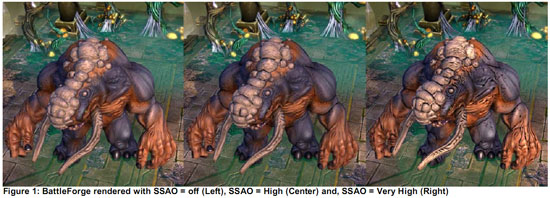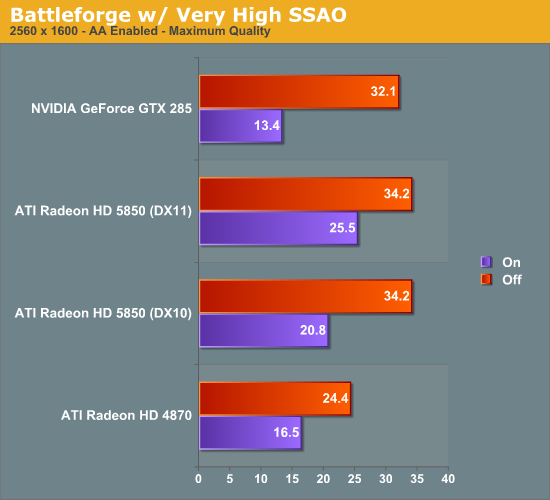AMD’s Radeon HD 5850: The Other Shoe Drops
by Ryan Smith on September 30, 2009 12:00 AM EST- Posted in
- GPUs
Battleforge: The First DX11 Game
As we mentioned in our 5870 review, Electronic Arts pushed out the DX11 update for Battleforge the day before the 5870 launched. As we had already left for Intel’s Fall IDF we were unable to take a look at it at the time, so now we finally have the chance.
Being the first DX11 title, Battleforge makes very limited use of DX11’s features given that the hardware and the software are still brand-new. The only thing Battleforge uses DX11 for is for Compute Shader 5.0, which replaces the use of pixel shaders for calculating ambient occlusion. Notably, this is not a use that improves the image quality of the game; pixel shaders already do this effect in Battleforge and other games. EA is using the compute shader as a faster way to calculate the ambient occlusion as compared to using a pixel shader.

The use of various DX11 features to improve performance is something we’re going to see in more games than just Battleforge as additional titles pick up DX11, so this isn’t in any way an unusual use of DX11. Effectively anything can be done with existing pixel, vertex, and geometry shaders (we’ll skip the discussion of Turing completeness), just not at an appropriate speed. The fixed-function tessellater is faster than the geometry shader for tessellating objects, and in certain situations like ambient occlusion the compute shader is going to be faster than the pixel shader.
We ran Battleforge both with DX10/10.1 (pixel shader SSAO) and DX11 (compute shader SSAO) and with and without SSAO to look at the performance difference.

Update: We've finally identified the issue with our results. We've re-run the 5850, and now things make much more sense.
As Battleforge only uses the compute shader for SSAO, there is no difference in performance between DX11 and DX10.1 when we leave SSAO off. So the real magic here is when we enable SSAO, in this case we crank it up to Very High, which clobbers all the cards as a pixel shader.
The difference from in using a compute shader is that the performance hit of SSAO is significantly reduced. As a DX10.1 pixel shader it lobs off 35% of the performance of our 5850. But calculated using a compute shader, and that hit becomes 25%. Or to put it another way, switching from a DX10.1 pixel shader to a DX11 compute shader improved performance by 23% when using SSAO. This is what the DX11 compute shader will initially be making possible: allowing developers to go ahead and use effects that would be too slow on earlier hardware.
Our only big question at this point is whether a DX11 compute shader is really necessary here, or if a DX10/10.1 compute shader could do the job. We know there are some significant additional features available in the DX11 compute shader, but it's not at all clear on when they're necessary. In this case Battleforge is an AMD-sponsored showcase title, so take an appropriate quantity of salt when it comes to this matter - other titles may not produce similar results
At any rate, even with the lighter performance penalty from using the compute shader, 25% for SSAO is nothing to sneeze at. AMD’s press shot is one of the best case scenarios for the use of SSAO in Battleforge, and in the game it’s very hard to notice. For the 25% drop in performance, it’s hard to justify the slightly improved visuals.










95 Comments
View All Comments
merin - Tuesday, October 6, 2009 - link
Thanks Pastuch :)I'm in the process of getting a new graphics card, and I'm trying to find the most silent one that doesn't nerf performance from the top cards that much. The 3 cards that I'm considering is:
This 5850 from ATI (probably Sapphire or Asus)
Sapphire HD4890 Vapor-X
MSI N275GTX Twin Frozr OC
Any advice?
Pastuch - Wednesday, October 7, 2009 - link
I was looking at the the exact same cards. Both the Twin Forzr GTX275 and the Radeon 4890 vapor-x are VERY QUIET. I would pick based on which games you play. If you have a home theater and audio passthrough is a concern I would lean towards the ATI card. Both of them come pre-overclocked and both have stellar performance. The Twin Frozr is slightly longer in length; however it's power connectors face up (Not out the back of the card like usual).Ryan Smith - Monday, October 5, 2009 - link
Yes. That's the noise of our test rig that we measure at idle when using an entirely passive video card; we can get our rigs down to about 36dB, but that requires removing all the fans other than the CPU fan. Bear in mind that a dead quiet room is 30dB and that we're measuring roughly 6" away from the card, so our methodology may differ from how other people do it.merin - Tuesday, October 6, 2009 - link
Thank you Ryan!So what do you think is the most silent? This 5850 with a reference cooler or the 4890 vapor-x? I find them very hard to compare because of different methodology...
Right now, they only thing in my case that is making noise is the fan on my old 8800GTS, and I'd like my new card to make it completely silent if possible.
Ryan Smith - Tuesday, October 6, 2009 - link
Since we haven't tested the Vapor-X, I have no way of knowing.MamiyaOtaru - Friday, October 2, 2009 - link
260 core 216 is using more power yet running cooler with a quieter fan.. would love to see a 5850 with a more efficient coolerAnnonymousCoward - Thursday, October 1, 2009 - link
DisplayPort 1.1 vs 1.2 is the difference between PCIe 1.0 vs 2.0. The bandwidth is doubled. Please start stating the version.coconutboy - Thursday, October 1, 2009 - link
I didn't read all the comments yet so perhaps this has been mentioned, but where are all the 5850 Xfire results? Hopefully the Crossfire benches weren't done exclusively at 2560x1600? From some of Ryan's text in the article, it seems there were Crossfire results that are accidently missing or got pulled. Stuff like this quote from the Battleforge page 6 text:Yet there are no Xfire results on any of the Battleforge graphs. Hopefully they'll be added later. In the meantime guru3d and HardOCP have Xfire results for those interested.
coconutboy - Thursday, October 1, 2009 - link
Had a chance to go through all the comments now, seems TheOne pointed out the same thing on page 6 of the comments and Ryan attempted to fix it. The fix still ain't showing up in my browser though.Ryan Smith - Thursday, October 1, 2009 - link
It's really fixed this time. I had two sets of graphs, one with the CF/SLI cards and one without. I put up the wrong one.